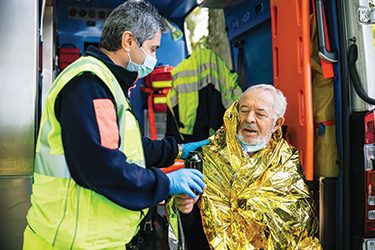Exposure-Related Injuries –
HYPERTHERMIA AND HYPOTHERMIA

The opportunity to enjoy the scenic splendor of the great outdoors is one of the major attractions of traveling, but it comes with a risk of injury due to exposure. The following are some of the primary dangers.
Hyperthermia
In temperate weather, the human body naturally regulates its core temperature to an average of 98.6°F (37°C), but an individual’s actual core temperature varies with daily sleep-wake cycles (and women’s monthly cycles) as well as from individual to individual.
Hyperthermia results when the body’s temperature is elevated well above normal, which can occur in an environment with a temperature much higher than the normal range. The lower limit of hyperthermia is poorly defined. Heat stroke can occur when a person’s core temperature exceeds 104°F (40°C). Extreme ultramarathon runners, however, have been known to sustain core temperatures as high as 108°F (42°C).
The state of acclimatization (adaptation to repeated or sustained high temperatures), the arduousness of any physical work and the relative humidity of the environment influence how a person’s core temperature responds to heat. Heat stress associated with high relative humidity increases dramatically at higher air temperatures. The body’s cooling mechanism relies not on sweating but on the evaporation of sweat — and the higher the relative humidity, the more evaporation is inhibited. To account for the effect of relative humidity, in 1990 the U.S. National Weather Service developed a heat index scale as a calibration of the apparent temperature.
Immersion in water represents the highest level of relative humidity. Because immersion prevents evaporative cooling and because of water’s huge capacity for holding heat, water temperatures that exceed 97°F (36°C) are not well tolerated by humans, particularly if they must also exert themselves. Recreational scuba divers rarely experience water temperatures that high, so hyperthermia typically occurs during surface- or land-based activities.
Symptoms: The signs and symptoms of hyperthermia vary according to the severity of the condition. Heat-stress disorders can be divided into the following five categories:
- Heat edema: Edema is the accumulation of excess fluid in the body’s tissues and cavities. Heat causes the blood vessels to dilate (expand), so fluid tends to pool in the arms and legs, resulting in a condition known as peripheral edema.
- Heat cramps: Heat, especially in combination with exercise, can cause a loss of water and electrolytes in the body, resulting in muscle cramps and spasms, especially in the calves, arms and abdomen.
- Heat syncope: Syncope is fainting or a temporary loss of consciousness. When heat leads to dilation of the peripheral blood vessels, blood pressure can drop and the amount of blood flowing to the brain can decline, which can result in fainting.
- Heat exhaustion: Heat exhaustion is caused by dehydration — the loss of water and electrolytes from the body. It is characterized by headache, nausea, vomiting, low blood pressure, dizziness, fatigue or temporary loss of consciousness. The victim’s mental status remains normal, and their rectal temperature remains below 104°F (40°C).
- Heat stroke: A more severe form of heat exhaustion, heat stroke is characterized by a pronounced change in mental status, severe headache, nausea, vomiting, loss of consciousness, often a cessation of sweating and a rectal temperature exceeding 104°F (40°C).
Treatment: Remove victims from the overheated environment as soon as signs or symptoms of hyperthermia are apparent. The greater the magnitude of the malady, the more aggressive the efforts to cool the victim should be.
- Heat edema is easily resolved with rest and elevation of the extremities.
- Heat cramps can be managed with an ice massage (rubbing an ice cube on the affected area for five minutes at a time), stretching and oral fluids.
- Heat syncope can be managed by placing victims in a resting, supine position (lying on their back, face up), with their extremities slightly elevated, and by monitoring their vital signs (blood pressure, heart rate, temperature and respiration).
- Heat exhaustion requires monitoring victims’ vital signs and core temperature, administering electrolyte-rich fluids such as Gatorade and ensuring rest and cooling. If victims become dizzy or their blood pressure drops when they stand up, intravenous fluids may be required.
- Heat stroke requires urgent cooling, monitoring of victims’ vital signs and core temperature, administering intravenous fluids and encouraging rest.
Cooling measures can be as simple as finding a seat in the shade for victims of minor heat maladies but as drastic as immersion in ice water for victims of heat stroke. Immediate cooling is critical in serious cases. Even though ice-water baths are uncomfortable, they have proven to be safe and effective for heat stroke victims. If a victim’s signs and symptoms do not begin to abate after treatment, especially if the individual appears to be getting warmer, immediately seek medical aid.
Prevention: Water temperatures high enough to cause hyperthermia are typically not a problem during a dive. More common stressors for divers are exposure to hot surface conditions, particularly when wearing insulated suits (especially drysuits) designed to protect them in cool or cold underwater conditions as well as when exerting themselves while carrying dive equipment on land.
Preventive measures for divers include adequate hydration, sufficient shade and the ability to rest and adjust or remove attire as required. Adequate hydration requires continual awareness of water intake when in hot environments — especially in hot and humid environments. The need for good hydration is increased for divers who experience a diuretic effect (promoting the production of urine) from wearing tight wetsuits or from immersion. Changes in diet, activity level and thermal status can influence the concentration of urine, but passing nearly clear, colorless urine several times per day is generally considered evidence of adequate hydration. If urine volume is reduced or its color darkens, drink more water or other stimulant-free fluids.
Preventive measures for nondivers are similar: Maintain good hydration, stay in the shade outdoors or in air-conditioned spaces indoors, pace activity levels, and dress appropriately for the heat (in light colors, for example). In conditions of extreme heat, it may be necessary to drink electrolyte-rich fluids.
Hypothermia
Hypothermia results when the body’s core temperature drops below 95°F (35°C), which can occur in an environment with a temperature much lower than the normal range.
In a cold environment, your body loses heat faster than it can produce it — at a rate that is affected by the temperature gradient between your skin and the environment, the heat capacity of the environment (which is much greater for water than for air), the presence of wind or water movement (tides and currents hasten cooling), your body composition (both a higher lean-to-fat ratio and a lower body-mass-to-surface-area ratio hasten cooling) and how much protective clothing you are wearing.
Hypothermia often results from immersion in cold water, because water conducts heat away from the body 20 to 27 times faster than air does. If you are suddenly immersed in water colder than 59°F (15°C) without thermal protection, the shock can cause an inhalation gasp response, which can induce you to inhale water. The stress response also triggers an extremely rapid heart and breathing rate. The cold shock may be accompanied by pain and mental disorientation, which can lead to fear and panic. Good thermal protection such as a wetsuit, drysuit or other survival-type gear will dramatically lessen the immediate effects of immersion in cold water, but heat loss will still occur over time.
You can increase the rate at which your body produces heat by exercising or shivering; if you are immersed in cold water while wearing little or no thermal protection, however, swimming actually increases your exposed surface area and thus elevates the rate at which your body heat is transferred to the water. In general, you can maintain your core temperature by swimming only in water that’s warmer than 75°F (24°C). An unprotected swimmer’s core temperature will usually drop in water colder than that. An inability to continue swimming — a condition known as swimming failure — typically develops more rapidly in cold water than one expects.
If you are not wearing thermal protection when immersed in cold water but have buoyancy support such as a life jacket and a chance of rescue, remain still in a position that minimizes your exposed surface area. Pull your knees together and up to your chest in what is known as the heat-escape-lessening position (HELP) or the rescue position; it provides improved protection of the body’s high-heat-loss areas, which are the armpits, groin, chest and thighs.
Immersion-related hypothermia can also occur in relatively warm or even tropical waters as a result of the body slowly cooling over time. This may happen if you are in water as warm as 84°F to 91°F (29°C to 33°C) if you are not wearing any thermal protection. In such circumstances, you may not be aware of the slow heat drain for some time.
Hypothermia can also occur in surface or land settings. The same factors — including the temperature of your environment, the presence of wind and how appropriately you are dressed for the conditions — are key in whether you are likely to develop hypothermia and how soon it might happen. Similarly, even a slightly cool temperature can result in cold stress, depending on an individual’s age, health status, body-fat ratio and body mass.
Symptoms: The signs and symptoms of cold stress vary according to how severe the condition is. Table 9 describes the various gradations of hypothermia.
Treatment: Individuals with mild hypothermia will be awake, conversing lucidly, complaining about the cold and probably shivering. Assuming no other injuries are present, mildly hypothermic victims can be rewarmed with a variety of passive or active techniques and with minimal risk of complications. If travelers suffer hypothermia in a remote setting, many rewarming options, particularly more aggressive and invasive techniques, likely will not be available; nevertheless, rescuers must do what they can to protect victims from further injury.
The essential first step is to remove any wet clothing and replace it with a dry insulating inner layer and a windproof outer layer, including covering the head. Shivering can provide effective rewarming in cases of mild hypothermia. Exercising can also increase the rewarming rate, but it will slightly increase afterdrop — a continued decline in victims’ core temperature even after their removal from the cold stress — but this is typically not problematic in cases of mild hypothermia. Fully alert and cooperative victims of hypothermia can also drink warm liquids, which deliver negligible amounts of heat but help offset associated dehydration and provide a sense of comfort. Most beverages are suitable, but avoid alcohol, which can compromise victims’ awareness and exacerbate dehydration and vasodilatation (expansion of the blood vessels). Food can improve victims’ energy reserves, but it is not a critical immediate need for well-nourished victims.
Individuals with moderate hypothermia will be conscious but may be confused, apathetic or uncooperative and may have difficulty speaking. Their condition demands more caution, because cardiac arrhythmias (disturbances of the heart’s rhythm) are possible. Gentle handling and active rewarming techniques — such as using heated blankets, forced-air rewarming, and heated and humidified breathing gas — are all desirable if available. Exercise is not recommended for individuals with moderate hypothermia because of the victims’ compromised physical coordination and the potential for increasing afterdrop. Afterdrop can raise the risk of physiological collapse, especially during or shortly after a rescue from immersion-related hypothermia. Keeping victims supine (lying face up on their back), with their heart and head at similar levels, and completely at rest will reduce the risk of collapse.
Use the most effective alternatives available when rewarming. Take care to insulate victims from the ground or other cold surfaces (consider using a dry wetsuit as an insulated mattress). A warm-water bath is another good option for victims of moderate hypothermia, but it is essential to physically support them throughout their transfer to the bath and their immersion. The initial bathwater temperature should be lukewarm, not more than 105°F (41°C), to minimize the sensation of burning that victims may experience. After immersing the victim in the bath, you can progressively increase the water temperature to no more than 113°F (45°C). If hot water isn’t available, use chemical packs or electric pads to rewarm moderately hypothermic individuals, but avoid burns by never applying these items directly to the skin.
Individuals with severe hypothermia may be unconscious, have a slowed heart rate and respiration or may even appear dead, with no detectable heartbeat. Look carefully for signs of life such as breathing, movement or a pulse in the carotid artery (neck). First assess their breathing and then their pulse for at least one minute to confirm either respiratory arrest or pulseless cardiac arrest, which would necessitate CPR. If hypothermia is caused by cold-water immersion, death usually results from loss of consciousness and subsequent drowning. If drowning precedes hypothermia, successful resuscitation is unlikely. But if victims show breathing or movement, their heart is still beating, even if at a slow rate. Spending sufficient time to check for a pulse is essential. If there is either breathing or a heartbeat, external heart massage (chest compression) is not needed.
For the unconscious hypothermic individual, the main goals are to maintain adequate blood pressure and respiration and to prevent further heat loss. Severe hypothermia leaves victims susceptible to cardiac arrest, so it is essential to provide extremely gentle handling — putting them in a supine position with their head and heart at the same level, fully supporting them and keeping them from all physical activity — as well as aggressive, often invasive rewarming strategies. Cardiac arrhythmias may result from severe hypothermia or even from rewarming a severely hypothermic individual. Providing basic life support takes precedence over efforts to rewarm a victim.
If a hypothermic individual shows no signs of life, begin CPR and make arrangements for emergency transport to the nearest medical facility. Rewarming victims of severe hypothermia is unlikely in the field, but it is essential to protect them against further heat loss. If CPR is required, continue performing it until medical assistance arrives. There have been successful resuscitations after prolonged CPR, in part because of some naturally protective effects of hypothermia. Victims who appear clinically dead due to marked decline in their brain and cardiovascular function can sometimes be fully resuscitated with their neurological functions intact. For more information about performing CPR, see cpr.heart.org/en/resources/what-is-cpr, or learn about DAN first aid courses at DAN.org/education-events/instructor-led-courses. The outlook is poor for adults who have a core temperature below 82°F (28°C), have been immersed for more than 50 minutes, have life-threatening injuries or are more than four hours away from definitive medical care.
Discontinue CPR for hypothermic individuals only under the following conditions:
- The person is successfully resuscitated.
- The rescuers become too fatigued to continue.
- The person has been completely rewarmed but is still unresponsive to properly administered CPR.
- A medically qualified individual arrives at the scene, examines the victim and declares the person dead.
- We advise following these steps after a cold-water immersion incident:
- Determine the cause of the immersion to reduce risk to the rescuers.
- Handle the victim as gently as possible.
- Assess the victim for responsiveness and normal breathing, and be aware of the increased risk of cardiac arrest while the victim is being handled and removed from the water.
- If you think an injury occurred, support and immobilize the victim’s neck as well as possible.
- If breathing is absent, begin CPR, and continue performing it until medical personnel arrive.
- Give the victim as much oxygen as possible.
- Arrange transport to a medical facility.
- Prevent further heat loss.
- Rewarm as needed and as the situation allows.
- The protocol for aiding victims of nonimmersion-related hypothermia are the same, except for the steps related specifically to immersion.
Prevention: If you plan to swim or dive in cool or cold water, preventing hypothermia requires preparation. It is essential that divers understand the proper use of protective garments to conserve their body heat and control heat loss. Most divers will benefit from wearing thermal protection in water cooler than 80°F (27°C). Significant thermal stress can be expected in water colder than 75°F (24°C). Divers should ensure that they have the proper protective equipment as well as training and experience in how to dive safely in cool or cold water. Immersion in cold water without thermal protection results in incapacitation more quickly than one might expect. An additional aspect of preparation involves training and readiness in case a rescue (or self-rescue) is necessary; rapid action greatly increases the likelihood of a successful outcome.
If you plan to engage in surface- or land-based activities, preventing hypothermia requires wearing appropriate clothing for the conditions; dressing in layers and wearing a hat to prevent body heat from escaping from your head are especially beneficial. It is important to stay dry and avoid overexertion, which can cause you to sweat and get chilled if the sweat cools before it evaporates.

Heat stroke can occur when a person’s core temperature exceeds 104°F (40°C).

Hypothermia often results from immersion in cold water, because water conducts heat away from the body 20 to 27 times faster than air does.
Table 9.
Signs and Symptoms
of Hypothermia

Immersion-related hypothermia can also occur in relatively warm or even tropical waters as a result of the body slowly cooling over time.
DAN Customer Service
Mon–Fri, 8:30 a.m. – 5 p.m. ET
+1 (919) 684-2948
+1 (800) 446-2671
Fax: +1 (919) 490-6630
24/7 Emergency Hotline
In event of a dive accident or injury, call local EMS first, then call DAN.
24/7 Emergency Hotline:
+1 (919) 684-9111
(Collect calls accepted)
DAN must arrange transportation for covered emergency medical evacuation fees to be paid.
Medical Information Line
Get answers to your nonemergency health and diving questions.
Mon–Fri, 8:30 a.m. – 5 p.m. ET
+1 (919) 684-2948, Option 4
Online: Ask A Medic
(Allow 24-48 hours for a response.)